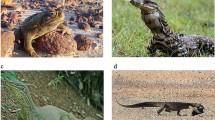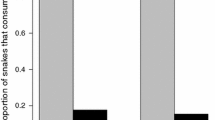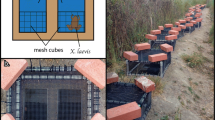Abstract
The magnitude of impact of an invasive species on native taxa, and the time course of recovery, depend on the native’s ability to adjust to the invader. Here, we examine the impact of a toxic invasive prey species (cane toad Rhinella marina) on a vulnerable top-predator (lace monitor Varanus varius) in southern Australia. Lace monitor populations crash as soon as toads invade, as occurs in related species in tropical Australia. The toad’s impact falls primarily on larger lizards, such that mean body sizes decline precipitously after toad arrival. Feeding trials with free-ranging lizards clarified the reasons for that size-biased vulnerability. Large lizards attacked novel prey more rapidly than did smaller conspecifics, especially in toad-naïve populations. Small lizards were more cautious in investigating novel prey (more tongue flicks and bites prior to ingestion) and swallowed the item more slowly. These traits may allow smaller lizards to detect and avoid toad toxins. Seventy percent of monitors from toad-naïve populations readily consumed dead cane toads (with parotoid glands removed) and 85 % consumed frogs. In contrast, no conspecifics from toad-exposed populations consumed toads whereas 40 % ate frogs. Following a single meal of toxic toad (typically eliciting illness), all monitors refused toads but 40 % continued to eat frogs. Lace monitors thus can rapidly learn taste aversion to cane toads. This behavioral plasticity enables survival of smaller lizards (that approach and process prey more cautiously than their larger relatives), and may explain this species’ recovery in long-term toad-colonized regions of northern Australia.




Similar content being viewed by others
References
Ashley MV, Willson MF, Pergams ORW, O’Dowd DJ, Gende SM, Brown JS (2003) Evolutionarily enlightened management. Biol Conserv 111:115–123
Auffenberg W (1984) Notes on feeding behaviour of Varanus bengalensis. J Bombay Nat Hist Soc 80:286–302
Banks PB, Newsome AE, Dickman CR (2000) Predation by red foxes limits recruitment in populations of eastern grey kangaroos. Austral Ecol 25:283–291
Beckmann C, Shine R (2011) Toad’s tongue for breakfast: exploitation of a novel prey type, the invasive cane toad, by scavenging raptors in tropical Australia. Biol Invasions 13:1447–1455
Beckmann C, Crossland MR, Shine R (2011) Responses of Australian wading birds to a novel toxic prey type, the invasive cane toad Rhinella marina. Biol Invasions 13:2925–2934
Brown GP, Phillips BL, Shine R (2011) The ecological impact of invasive cane toads on tropical snakes: field data do not support laboratory-based predictions. Ecology 92:422–431
Brown GP, Ujvari B, Madsen T, Shine R (2013) Invader impact clarifies the roles of top-down and bottom-up effects on tropical snake populations. Funct Ecol 27:351–361
Burghardt GM, Chiszar D, Murphy JB, Romano J, Walsh T, Manrod J (2002) Behavioral complexity, behavioral development, and play. In: Murphy JB, Ciofi C, de La Panouse C, Walsh T (eds) Komodo Dragons: biology and conservation. Smithsonian Institution Press, Washington, pp 78–118
Cabrera-Guzman E, Crossland MR, Shine R (2012) Predation on the eggs and larvae of invasive cane toads (Rhinella marina) by native aquatic invertebrates in tropical Australia. Biol Conserv 153:1–9
Caller G, Brown C (2013) Evolutionary responses to invasion: cane toad sympatric fish show enhanced avoidance learning. PLoS One 8:e54909
Carroll SP (2007) Natives adapting to invasive species—ecology, genes, and the sustainability of conservation. Ecol Res 22:892–901
Carroll SP (2008) Facing change: forms and foundations of contemporary adaptation to biotic invasions. Mol Ecol 17:361–372
Cooper WE Jr (1997) Independent evolution of squamate olfaction and vomerolfaction and correlated evolution of vomerolfaction and lingual structure. Amphib Reptil 18:85–105
Cooper WE Jr, Habegger JJ (2001) Responses by juvenile savannah monitor lizards (Varanus exanthematicus) to chemical cues from animal prey, plants palatable to herbivores, and conspecifics. J Herpetol 35:618–624
Crossland MR (2001) Ability of predatory native Australian fishes to learn to avoid toxic larvae of the introduced toad Bufo marinus. J Fish Biol 59:319–329
Daly JW, Highet RJ, Myers CW (1984) Occurrence of skin alkaloids in non-dendrobatid frogs from Brazil (Bufonidae), Australia (Myobatrachidae), and Madagascar (Mantellinae). Toxicon 22:905–919
Dickman CR (1996) Impact of exotic generalist predators on the native fauna of Australia. Wildl Biol 2:185–195
Doody JS, Castellano CM, Rhind D, Green B (2013) Indirect facilitation of a native mesopredator by an invasive species: are cane toads re-shaping tropical riparian communities? Biol Invasions 15:559–568
Garrett CM, Card WC (1993) Chemical discrimination of prey by naive neonate Gould’s monitors Varanus gouldii. J Chem Ecol 19:2599–2604
Greenlees MJ, Shine R (2010) Impacts of eggs and tadpoles of the invasive cane toad (Bufo marinus) on aquatic predators in tropical Australia. Austral Ecol 36:53–58
Greenlees M, Phillips BL, Shine R (2010) Adjusting to a toxic invader: native Australian frogs learn not to prey on cane toads. Behav Ecol 21:966–971
Guarino F (2001) Diet of a large carnivorous lizard, Varanus varius. Wildl Res 28:627–630
Gustavson CR, Gustavson JC (1985) Predation control using conditioned food aversion methodology: theory, practice, and implication. Ann NY Acad Sci 443:348–356
Hayes RA, Crossland MR, Hagman M, Capon RJ, Shine R (2009) Ontogenetic variation in the chemical defences of cane toads (Bufo marinus): toxin profiles and effects on predators. J Chem Ecol 35:391–399
Heinze G (2006) A comparative investigation of methods for logistic regression with separated or nearly separated data. Stat Med 25:4216–4226
Imansyah MJ, Jessop TS, Ciofi C, Akbar Z (2008) Ontogenetic differences in the spatial ecology of immature Komodo dragons. J Zool 274:107–115
Jessop TS, Urlus J, Lockwood T, Gillespie G (2010) Preying possum: assessment of the diet of lace monitors (Varanus varius) from coastal forests in eastern Victoria. Biawak 4:59–66
Jessop TS, Smissen P, Scheelings F, Dempster T (2012) Demographic and phenotypic effects of human mediated trophic subsidy on a large Australian lizard (Varanus varius): meal ticket or last supper? PLoS One 7:e34069
Jolly CJ, Shine R, Greenlees MJ (2015) The impact of invasive cane toads on native wildlife in southern Australia. Ecol Evol 5:3879–3894
Kaufman JD, Burghardt GM, Phillips JA (1996) Sensory cues and foraging decisions in a large carnivorous lizard, Varanus albigularis. Anim Behav 52:727–736
Kearney M, Phillips BL, Tracy CR, Christian K, Betts G, Porter WP (2008) Modelling species distributions without using species distributions: the cane toad in Australia under current and future climates. Ecography 31:423–434
Kokko H, Sutherland WJ (2001) Ecological traps in changing environments: ecological and evolutionary consequences of a behaviourally mediated allee effect. Evol Ecol Res 3:537–551
Kolbe JJ, Kearney M, Shine R (2010) Modeling the consequences of thermal trait variation for the cane toad invasion of Australia. Ecol Appl 20:2273–2285
Lever C (2001) The cane toad. The history and ecology of a successful colonist. Westbury Academic and Scientific Publishing, Otley
Llewelyn J, Webb JK, Schwarzkopf L, Alford R, Shine R (2010a) Behavioural responses of carnivorous marsupials (Planigale maculata) to toxic invasive cane toads (Bufo marinus). Austral Ecol 35:560–567
Llewelyn J, Schwarzkopf L, Alford R, Shine R (2010b) Something different for dinner? Responses of a native Australian predator (the keelback snake) to an invasive prey species (the cane toad). Biol Invasions 12:1045–1051
Llewelyn J, Schwarzkopf L, Phillips BL, Shine R (2013) After the crash: how do predators adjust following the invasion of a novel toxic prey type? Austral Ecol 39:190–197
Lloyd R (2006) The lace monitor (Varanus varius) in a tropical island ecosystem: an ecological study into its role as a predator of rainbow skinks (Carlia sp.). Honours thesis. James Cook University, Townsville, Queensland
Losos JB, Greene HW (1988) Ecological and evolutionary implications of diet in monitor lizards. Biol J Linn Soc 35:379–407
Lowe S, Browne M, Boudjelas S, De Poorter M (2000) 100 of the world’s worst invasive species: a selection from the global invasive species database. International Union for Conservation of Nature, Auckland
Mack RN, Simberloff D, Lonsdale WM, Evans H, Clout M, Bazzaz FA (2000) Biotic invasions: causes, epidemiology, global consequences, and control. Ecol Appl 10:689–710
Manrod JD, Hartdegen R, Burghardt GM (2008) Rapid solving of a problem apparatus by juvenile black-throated monitor lizards (Varanus albigularis albigularis). Anim Cogn 11:267–273
McCann S, Greenlees MJ, Newell D, Shine R (2014) Rapid acclimation to cold allows the cane toad (Rhinella marina) to invade montane areas within its Australian range. Funct Ecol 28:1166–1174
McGeoch MA, Butchart SHM, Spear D, Marais E, Kleynhans EJ, Symes A, Chanson J, Hoffman M (2010) Global indicators of biological invasion: species numbers, biodiversity impact and policy responses. Divers Distrib 16:95–108
Melbourne BA, Cornell HV, Davies KF, Dugaw CJ, Elmendorf S, Freestone AL (2007) Invasion in a heterogeneous world: resistance, coexistence or hostile takeover? Ecol Lett 10:77–94
Mery F, Burns JG (2010) Behavioural plasticity: an interaction between evolution and experience. Evol Ecol 24:571–583
Metcalfe DC, Jones AA (2012) Varanus varius: natural history notes. Herpetol Bull 122:40–41
Mooney HA, Cleland EE (2001) The evolutionary impact of invasive species. Proc Natl Acad Sci USA 98:5446–5451
Morosinotto C, Thomson RL, Hanninen M, Korpimaki E (2012) Higher nest predation risk in association with a top predator: mesopredator attraction? Oecologia 170:507–515
Nelson DWM, Crossland MR, Shine R (2011a) Behavioural responses of native predators to an invasive toxic prey species. Austral Ecol 36:605–611
Nelson DWM, Crossland MR, Shine R (2011b) Foraging responses of predators to novel toxic prey: effects of predator learning and relative prey abundance. Oikos 120:152–158
Nicolaus LK, Farmer PV, Gustavson CR, Gustavson JC (1989) The potential of oestrogen-based conditioned aversion in controlling depredation: a step closer towards the ‘Magic Bullet’. Appl Anim Behav Sci 23:1–14
O’Donnell S, Webb JK, Shine R (2010) Conditioned taste aversion enhances the survival of an endangered predator imperiled by a toxic invader. J Appl Ecol 47:558–565
Pearson DJ, Webb JK, Greenlees MJ, Phillips BL, Bedford GS, Brown GP, Thomas J, Shine R (2014) Behavioural responses of reptile predators to invasive cane toads in tropical Australia. Austral Ecol 39:448–454
Phillips BL, Shine R (2004) Adapting to an invasive species: toxic cane toads induce morphological change in Australian snakes. Proc Natl Acad Sci USA 101:17150–17155
Phillips BL, Shine R (2006a) Spatial and temporal variation in the morphology (and thus, predicted impact) of an invasive species in Australia. Ecography 29:205–212
Phillips BL, Shine R (2006b) An invasive species induces rapid adaptive change in a native predator: cane toads and black snakes in Australia. Proc R Soc B 273:1545–1550
Phillips BL, Brown GP, Webb JK, Shine R (2006) Invasion and the evolution of speed in toads. Nature 439:803
Phillips BL, Brown GP, Greenlees M, Webb JK, Shine R (2007) Rapid expansion of the cane toad (Bufo marinus) invasion front in tropical Australia. Austral Ecol 32:169–176
Phillips BL, Greenlees MJ, Brown GP, Shine R (2010) Predator behaviour and morphology mediates the impact of an invasive species: cane toads and death adders in Australia. Anim Conserv 13:53–59
Pianka ER, Vitt LJ (2003) Lizards: windows to the evolution of diversity. University of California Press, Berkeley
Price-Rees S, Webb JK, Shine R (2011) School for skinks: can conditioned taste aversion enable bluetongue lizards (Tiliqua scincoides) to avoid toxic cane toads (Rhinella marina) as prey? Ethology 117:749–757
R Development Core Team (2011) R: a language and environment for statistical computing. R Foundation for Statistical Computing, Vienna, Austria. http://www.R-project.org/
Rayner MJ, Hauber ME, Imber MJ, Stamp RK, Clout MN (2007) Spatial heterogeneity of mesopredator release within an oceanic island system. Proc Natl Acad Sci USA 104:20862–20865
Robbins TR, Langkilde T (2012) The consequences of lifetime and evolutionary exposure to toxic prey: changes in avoidance behaviour through ontogeny. J Evol Biol 25:1937–1946
Shine R (2010) The ecological impact of invasive cane toads (Bufo marinus) in Australia. Q Rev Biol 85:253–291
Shine R (2012) Invasive species as drivers of evolutionary change: cane toads in tropical Australia. Evol Appl 5:107–116
Shine R (2014) A review of ecological interactions between native frogs and invasive cane toads in Australia. Austral Ecol 39:1–16
Shine R, Brown GP, Phillips BL (2011) An evolutionary process that assembles phenotypes through space rather than time. Proc Natl Acad Sci USA 108:5708–5711
Smith JG, Phillips BL (2006) Toxic tucker: the potential impact of cane toads on Australian reptiles. Pac Conserv Biol 12:40–49
Somaweera R, Shine R (2012) The (non) impact of invasive cane toads on freshwater crocodiles at Lake Argyle in tropical Australia. Anim Conserv 15:152–163
Somaweera R, Webb JK, Brown GP, Shine R (2011) Hatchling Australian freshwater crocodiles rapidly learn to avoid toxic invasive cane toads. Behaviour 148:501–517
Ujvari B, Madsen T (2009) Invasion of cane toads associated with a significant increase in mortality in a naive Australian varanid lizard. Herpetol Conserv Biol 4:248–251
Ujvari B, Mun H, Conigrave AD, Bray A, Osterkamp J, Halling P, Madsen T (2012) Isolation breeds naivety: island living robs Australian varanid lizards of toad-toxin immunity via four-base-pair mutation. Evolution 67:289–294
Urban MC, Phillips BL, Skelly DK, Shine R (2007) The cane toad’s (Chaunus marinus) increasing ability to invade Australia is revealed by a dynamically updated range model. Proc R Soc B 274:1413–1419
Weavers BW (2004) Varanus varius. In: Pianka ER, King D (eds) Varanoid lizards of the world. Indiana University Press, Bloomington, pp 488–502
Webb JK, Brown GP, Child T, Greenlees MJ, Phillips BL, Shine R (2008) A native dasyurid predator (common planigale, Planigale maculata) rapidly learns to avoid a toxic invader. Austral Ecol 33:821–829
Williams CR, Brodie ED Jr, Tyler MJ, Walker SJ (2000) Antipredator mechanisms of Australian frogs. J Herpetol 34:431–443
Wilson SK (2012) Australian lizards: a natural history. CSIRO Publishing, Collingwood
Acknowledgments
We thank the staff from New South Wales National Parks and Wildlife Services for granting access to study sites. We thank Melanie Elphick for assistance with graphics and formatting. Mathew Crowther assisted with data analysis. This research was conducted with approval from the University of Sydney Animal Ethics Committee (protocol #2013/6043).
Funding
This work was supported by funding provided to R. S. by the Australian Research Council (Grant #120100074).
Author information
Authors and Affiliations
Corresponding author
Rights and permissions
About this article
Cite this article
Jolly, C.J., Shine, R. & Greenlees, M.J. The impacts of a toxic invasive prey species (the cane toad, Rhinella marina) on a vulnerable predator (the lace monitor, Varanus varius). Biol Invasions 18, 1499–1509 (2016). https://doi.org/10.1007/s10530-016-1097-2
Received:
Accepted:
Published:
Issue Date:
DOI: https://doi.org/10.1007/s10530-016-1097-2




